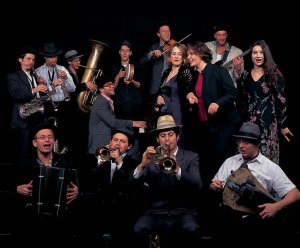| B i o g r a p h y |
 The Sandy Lopicic Orkestar
consists of 15 musicians from different Middle and South-East European
countries. It incorporates Deishovida, and thus Lothar Lässer on
chromatic button accordion. They play Bulgarian, Gypsy/Roma,
Macedonian, Serbian, Albanian, Bosnian and Montenegrin songs.
The Sandy Lopicic Orkestar
consists of 15 musicians from different Middle and South-East European
countries. It incorporates Deishovida, and thus Lothar Lässer on
chromatic button accordion. They play Bulgarian, Gypsy/Roma,
Macedonian, Serbian, Albanian, Bosnian and Montenegrin songs.
How can you describe music? What words would you have to link
together to achieve what music achieves? You may believe that the
genius of a writer is capable of evoking similar emotions, perhaps even
of a similar intensity. And words too, like sounds, can be companions
on the journey: The journey to where? To the depths of the soul? To the
centre of the cosmos? But at some point or other, words fall by the
wayside. The terrain becomes too slippery for their spindly
letter-legs, and only music remains to accompany us along the way. All
music, including that by the Sandy Lopicic Orkestar, can be divided
into three categories: music itself (B), and what comes before and
after it (A and C). Whereas generally speaking, there is an increasing
demand for C – due to deaths caused by music in department stores
and the acoustic poisoning perpetrated by the practically allpervasive
background music – the opposite seems to be the case among fans
of the Sandy Lopicic Orkestar: C atrophies, or becomes A. The end of a
piece of music leads on directly to a state of joyful expectation. In
this case, one speaks of a phenomenon of the A-B-A-B-A-B type, meaning
very long macromolecular musical chains, which often come to an end in
C, very late in the night. Why is this so? How do these artists manage
to make music feel so forcefully present? For example: a waltz. What
would they do with a waltz, from the viewpoint of physics? It is well
known that the waltz has always been categorised as so-called low
energy music, because it is only three-quarters music, with one quarter
missing per beat. Scholars think that the Sandy Lopicic Orkestar would
simply reverse this, Inversion of the Beat Quanta, which from the
viewpoint of energy results in a 4/3 beat waltz, i.e.: - the music
pressure rises, - the effectiveness of the waltz breaks with the laws
of nature (waltz efficiency = 133%) - so-called “super-hard
music” is formed (i.e., music that is very very hard to play) -
applause reaches a critical mass, when everything and everyone in the
place is aglow and revolving, and the sad and the happy meld
(major-minor plasma). There is a lot more music in this than there is
room for, and so science is confronted with a puzzle. A quick look at
the musical scores reveals nothing extraordinary: the usual
iconography, partially indecipherable where the black ink signifies
tempo, otherwise those typical composers’ cave drawings so
mysterious to the lay-person.
The magic in the music played by the Sandy Lopicic Orkestar, therefore, can only lie in the members of the ensemble. And indeed, each one of them has something magically special. Inside Natasa MirkovicDeRo, for example, is her counterpart, a knowledgeably wise witch. Vesna Petkovic comes from the future. Asked what she was in her former life, she claimed that from life to life she has travelled the past more and more. And in the ocean inside Irina Karamarkovic floats a city in which she sails her whole inner world. Were you to compare music with soup, you could call the three female vocalists the ensemble’s herbs or spice; nutmeg, paprika, pepper. Soup is often underestimated. By its very nature, soup is a magic potion, both negative and positive, black and white: the witches’ brew in Macbeth, for example, or medicine which when taken hot works wonders with colds. The soup is the very essence of all its ingredients: the herbs and spices, the plants and the vegetables, the water, the minerals, and (if desired) the meat. It is due to its ingredients that soup can be described as a magical metaphor for the world. So can music. By analogy, music would be, as it were, a soup of a higher order. And the members of the band Deishovida – Kurt Bauer, Matthias Loibner and Lothar Lässer – who have joined the Sandy Lopicic Orkestar on this occasion, could be onions, parsley, or carrots of a higher order.
The Members are:
vocals:
vesna petkovic (serbia)
natasha mirkovic-dero (bosnia)
irina karamarkovic (kosovo)
sandy lopicic (bosnia) - keyboard
matthias loibner (austria) - hurdy-gurdy
kurt bauer (austria) - violin
richard winkler (austria) - alto saxophone, clarinet
janez vouk (slovenija) - trumpet
bojan petrovic (serbia) - trumpet
imre bozoki (serbia) - trumpet
michael bergbaur (austria) - trombone, tuba
sasenko prolic (bosnia) - bass
jörg mikula (austria) - drums
stefan bauer (austria) - sound